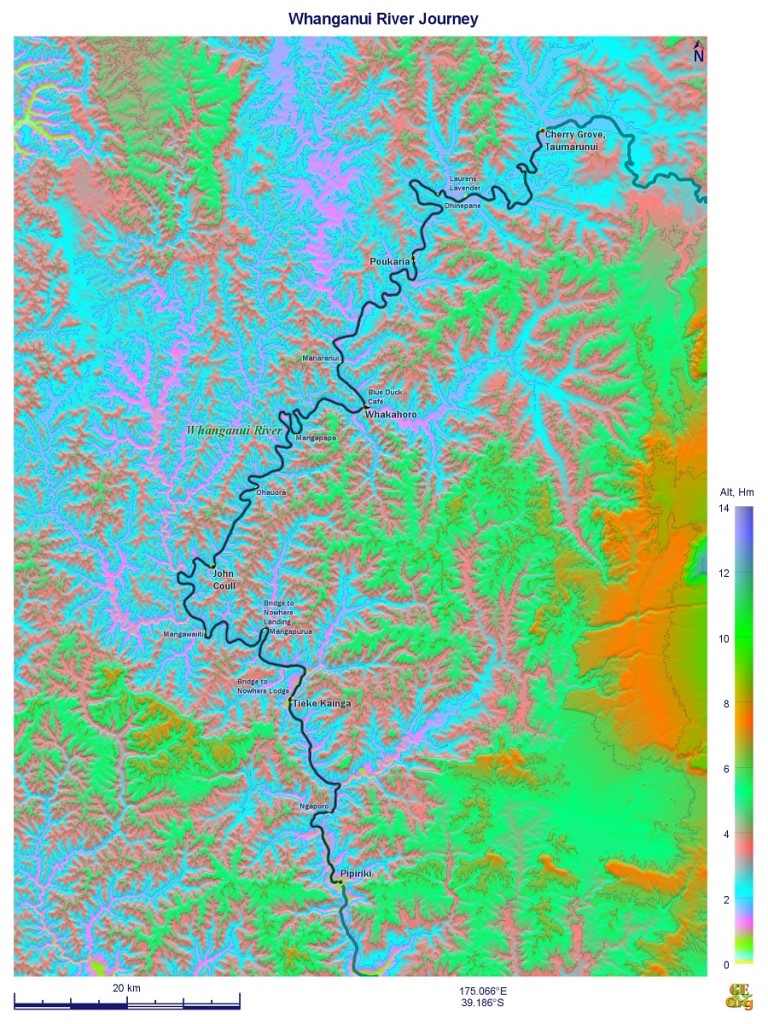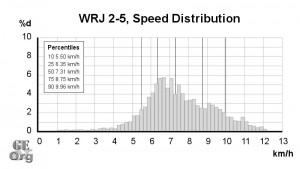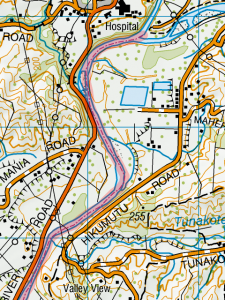Index
I’ve dealt with the kayak operators in the previous blog, now’s the time to look at my (our) side of things.
Travel Planning

The big problem here is that leaving Cherry Grove just after 11:00 for a 36 km leg is just too much for one day. The kayaking alone takes a good five hours, so only two rather restricted stops could be scheduled in order to get to Poukaria by dusk. Also, this is the roughest part of the whole trip, with at least two major rapids, the result of which is that everything is wet, and Poukaria Campsite lies so close to the river that overnight drying of kit is impossible.
A much better strategy would have been to schedule the stopover in Ohinepane (22 km), after taking at least one full lunch break beforehand, and an afternoon stop at Laurens Lavender (1381 River Rd, Aukopae 3991, laurenslavender.com, signposted on the river) for a cuppa and a slice of cake. This would mean a mid afternoon arrival at the campsite, after which everything could be dried, the dry bags repacked, etc. The following day Whakahoro could be reached after 35 km – again about five hours of paddling – but this time with a departure at around 9:00 (or even earlier) and two breaks along the way and arrival at the campsite by around 4:00 which seems realistic. Here again I would make better use of the Blue Duck Café (blueduckstation.co.nz, evening meals by prior arrangement) here to get some fresh food to eat, and of the location of the campsite and hut on higher ground just outside of the valley proper to allow the gear to dry.
So far this is just a redistribution of the first two days, but if you have time, I would suggest expanding the two days here to three, camping in Poukaria for night #2 and arriving in Whakahoro after what is only a half day’s paddle on the third day (22, 14, and 21 km respectively).

For the further journey I can only recommend taking four days instead of three to avoid a real bottleneck on the fourth (second if starting from Whakhoro) day, which is classically the stretch from John Coull to Tieke Kainga, with a stopover at the Bridge to Nowhere (29 km). With everyone from John Coull arriving at the landing point for the excursion to the Bridge to Nowhere at that same time it’s almost impossible to find a parking spot. Furthermore, if you want to get to Tieke Kainga in time for the powhiri, then you’ll be in a hurry at a time when the river is losing a bit of its momentum.

- Day 3 (1): Whakahoro – Ohauora (27 km)
- Day 4 (2): Ohauora – Mangawaiiti (20 km)
- Day 5 (3): Mangawaiiti – Mangapurua (Bridge to Nowhere landing, 9.5 km, 1 km return walk) – Tieke Kainga (total: 19.5 km)
- Day 6 (4): Tieke Kainga – Pipiriki (20.5 km) for a pickup at 2:00 pm
If there is no powhiri at Tieke Kainga, then perhaps dinner at the Bridge to Nowhere Lodge would be an alternative (bridgetonowhere.co.nz). Most of the kayak operators should be open to booking an extra day, and this should cost no more than about $40.
Food
Apart from making more avail of the opportunities along the way in this specific case, a paddling tour allows in general for more weight to be taken on board, i.e. to end the reliance on dried foods. I am indebted to my companion Pea for a couple of improvements she made to the basic food regime:
Oxo cubes for seasoning the rice (don’t know if there is a cheaper, generic brand of these things that could also be used), as well as tomato sauce as a universal condiment. Our rice with boiled shredded cabbage and carrots was almost as good as fried rice.
Butter. I managed to squash 250 g of butter into a corresponding screw top container, and it survived complete meltdown without noticeable leakage on at least two occasions. For my part, I could have lived off margarine, but Pea insisted on butter, and it worked.

Some Further Suggestions for Improvement
Different vegetables. Vegetables have to be fairly hard (non bruising) to survive for long enough to be eaten, so these could also be taken: Fennel, kohlrabi, parsnip, turnip, onions, potatoes, root celery. Also canned vegetables would be optimal for squishy varieties (see also below), and juices in tetra packs would make for some variety.
Rice. I can’t seem to find any parboiled rice less expensive than Uncle Ben’s which doesn’t require washing. So, perhaps, Uncle Ben’s in bags.
Waterproofing. Some extra work is required here, since the cabbage, once opened, is no longer waterproof, and if water gets into the inner air spaces it may start to rot. One solution would be to apportion the vegetables and waterproof them up front, so that only whole portions are used at any one time. Also some foodstuffs (such as coffee and sugar) have to be stored in absolutely waterproof containers from the get go.
Rat-proofing. The dry bags served fairly well for defence against rats, but ideally food should be stored in the hatches at night (preferably enclosed in the neoprene seals – one of ours was missing). I detected no rat predation, but that is probably more good luck than good preparation. Here canned vegetables would require no further protection.
Combining the previous two topics, apportioning the cheese up front might also have been a good idea. Also something has to be done about melt-proofing chocolate, perhaps also as buying smaller portions and finishing each portion after it is opened, rather than saving an already opened (and oversized) portion.
The Last Word
Change the camera cards every day if you bring along enough cards to do so, and secure the bloody camera, bozo. ‘Nuff said.
